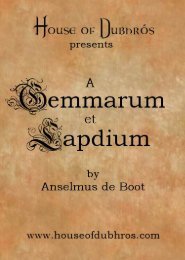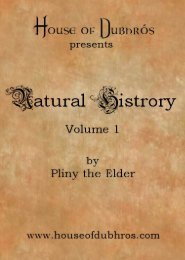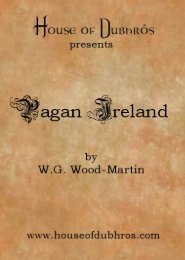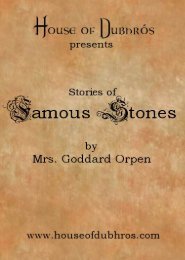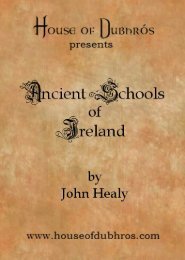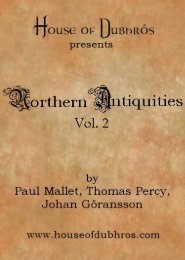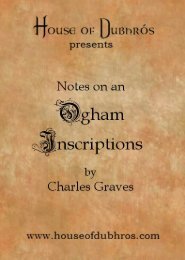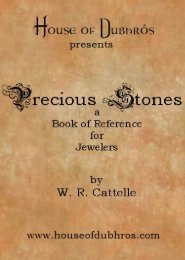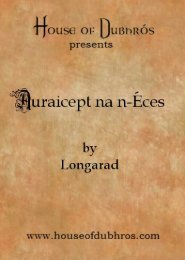Ogam Inscriptions in Ireland, Scotland, and ... - House of Dubhros
Ogam Inscriptions in Ireland, Scotland, and ... - House of Dubhros
Ogam Inscriptions in Ireland, Scotland, and ... - House of Dubhros
- No tags were found...
Create successful ePaper yourself
Turn your PDF publications into a flip-book with our unique Google optimized e-Paper software.
IN IRELAND, WALES, AND SCOTLAND. 5derivative, it is, most probably, the Tree-Rune, <strong>of</strong> which, Ibelieve, no examples have been found older than those <strong>of</strong>Maeshow, belong<strong>in</strong>g to the period <strong>of</strong> the Jerusalem pilgrimages.5._But the Irish Bethluisnion does not exist, as the Futhorc NO ori<strong>in</strong>aldoes, <strong>in</strong> the form <strong>of</strong> a lettered orig<strong>in</strong>al alphabet.None but 2Roman <strong>and</strong> Ogham letters have, as yet, been found on theCeltic monuments <strong>of</strong> these isl<strong>and</strong>s. The Bethluisnion is onlya vocabulary <strong>of</strong> letter-names adaptable to the letter-signs either<strong>of</strong> the Roman alphabet or <strong>of</strong> the fuller <strong>and</strong>, it is thought, the 4*older form <strong>of</strong> the Futhorc. If the Futhorc <strong>and</strong> Tree-Rune behas beenexcluded, we should conclude that the Oghamfounded on the Roman alphabet, re-named <strong>and</strong> marshalled<strong>in</strong>to the Beihluisnion sequence. The account, however, which Ogbam allegedthe Irish themselves give <strong>of</strong> it is, that it was brought <strong>in</strong> by the b^f -nearly half-mythical colony <strong>of</strong> the Tuatha de Danaan, whom theybr<strong>in</strong>g from the northern parts <strong>of</strong> the world through ^Gotl<strong>and</strong>. -$rwhich seems6. There is one feature <strong>in</strong> the Oghamto establish that its framers were <strong>of</strong> the Lat<strong>in</strong> rather thanthe Teutonic branch <strong>of</strong> the European family. The * h 'aicme (h, d, t, c, q) is apparently an anagramdrawn from the partly ana<strong>in</strong>itialletters <strong>of</strong> the card<strong>in</strong>al numbers, one, two, three, four, granjlJ 'Uc>five that is, <strong>in</strong> <strong>in</strong>sular Celtic speech, Jicen, da, tri, cathar, cuig.Whether it was an orig<strong>in</strong>al lost Irish alphabet, a Futhorc <strong>of</strong>the longer sort, or the Lat<strong>in</strong> alphabet <strong>of</strong> the Romans thatformed the foundation for the Ogham, it must be recognisedthat the people who adjustedit to its fourfold division <strong>and</strong>locative values <strong>in</strong> the Oghamic system did not express theirnumerals ' four " or " five " with an <strong>in</strong>itial p,as Teutonic or not TeutonicCymric speakers probably would have done. A fifth division or (J ) mric -<strong>of</strong> five further signs for the shorter expression <strong>of</strong> the diphthongshas been added, at a later date. It is called the Forfeada or The Forjiada.11over-trees," as be<strong>in</strong>g supplementary,<strong>and</strong> does not enter <strong>in</strong>tothe older examples.X o )X(The first <strong>and</strong> third <strong>of</strong> these are the only ones I have found <strong>in</strong>lapidary use.7. If derived from the Rune, its framers have not



